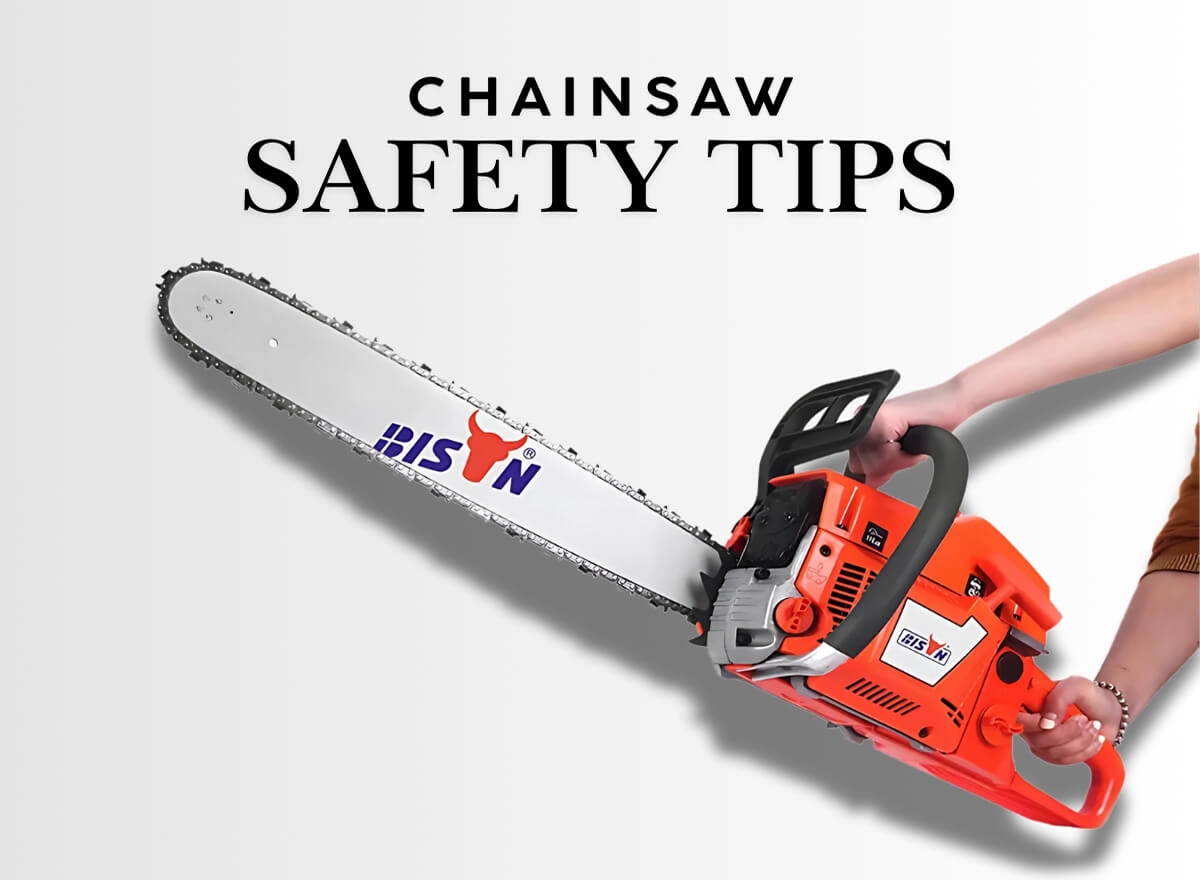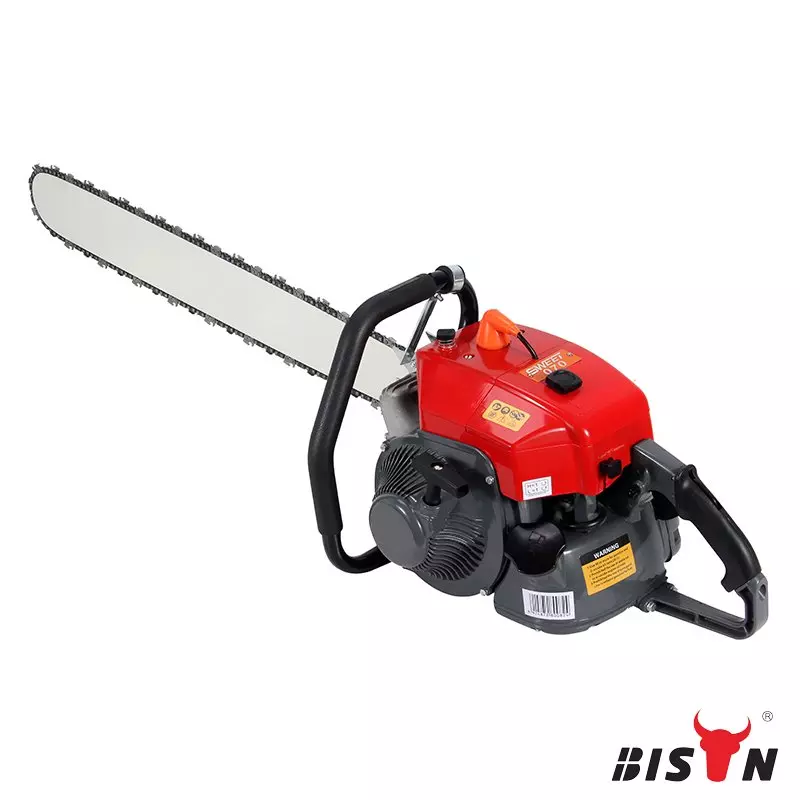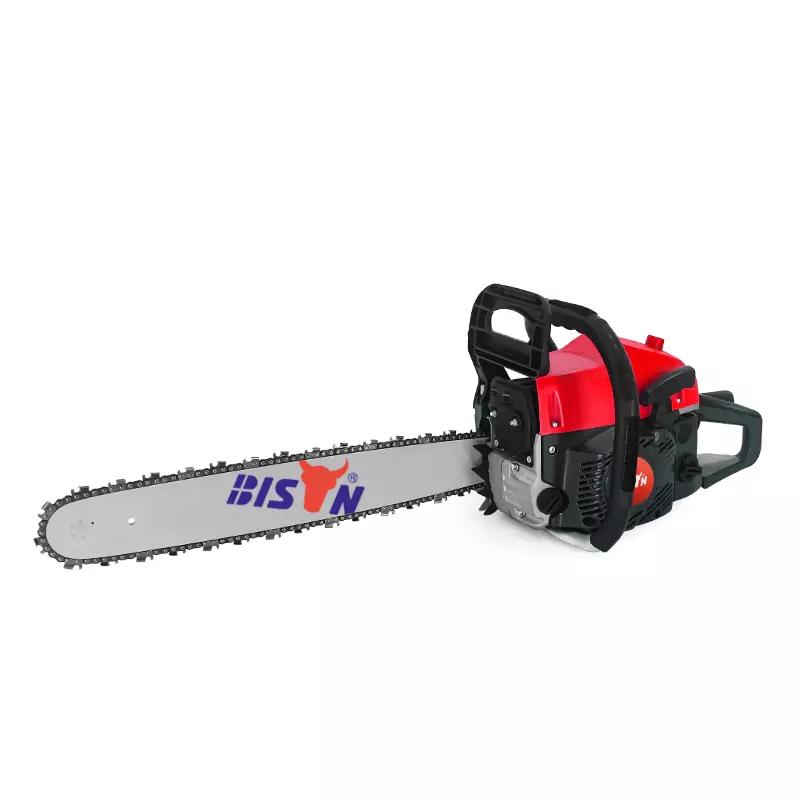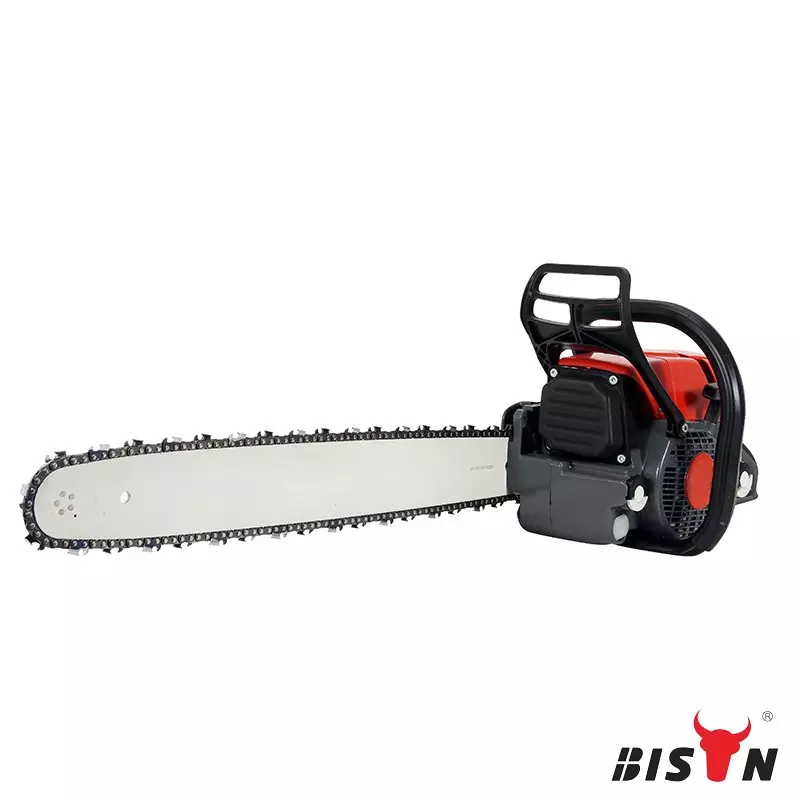comprehensive guide to safely using BISON chainsaws
2024-11-18
Table of content
Chainsaws are one of the most widely used garden power tools on the market. They are also one of the most dangerous tools, as chain saw safety measures are extremely complex. Even chain saw experts, such as professional arborists or champion lumberjacks, can encounter chain saw hazards.
As a leading chainsaw manufacturer in China, BISON is committed to providing top-quality products that prioritize safety and proper technique. This comprehensive guide will help you get the most out of your chainsaw while ensuring you can use it safely and effectively.

What are some common chainsaw accidents?
Most chainsaw injuries occur in the left leg and the back of the left hand. Every chainsaw operator should recognize these hazards before starting work. The most dangerous chainsaw hazards are:
Chainsaw kickback: Kickback occurs when the nose of the saw blade (kickback zone) hits an object and momentarily breaks or pinches. When a kickback occurs, the tip of the saw blade may move upward or even hit you with the tip of the blade.
Vibration sickness: Vibration sickness, also known as white finger syndrome or hand-arm vibration syndrome, is caused by the vibration of hand-held power tools, especially chainsaws.
Hearing loss: The noise produced by chain saw operation is a significant hazard to operators.
Carbon monoxide poisoning: Carbon monoxide (CO) poisoning is another underestimated risk among forestry workers and ranchers. Small gasoline engines emit dangerous amounts of carbon monoxide. CO is colorless, tasteless, and odorless. Even in small amounts, it is deadly. Working outdoors does not necessarily protect operators from CO poisoning. When exhaust is difficult to disperse, fumes can still accumulate and pose a danger to the operator and bystanders.
Electrical hazards: Any electric chain saw presents the potential for electrical fires and electrocution. Other electrical hazards with chainsaws include the risk of falling branches or trees and contact with electrical wires. Before working near electrical wires, verify that they are de-energized.
Fuel hazards: Gasoline chainsaws may also present fuel hazards such as using an incorrect fuel mixture, spilling fuel on the ground, using unapproved containers, and leaving fuel near heat sources.
How to use a chainsaw safely?
Learning how to use a chain saw safely can prevent operator error and potentially fatal accidents. The first rule of chain saw operation is to always follow the manufacturer's instructions.
Step 0: Pre-operation inspection and environmental assessment
Before starting a chainsaw, it is essential to perform a thorough inspection of the tool and assess the surroundings. This ensures your chainsaw is in good working order and helps identify potential hazards.
chainsaw inspection
Check the following components of your chainsaw before each use:
Chain tension: Make sure the chain is properly tensioned and is securely attached to the bar.
Chain sharpness: Verify that the chain's cutting teeth are sharp and undamaged.
Guide rods and sprockets: Inspect the guide rods and sprockets for wear or damage, and make sure the guide rods are properly lubricated.
Air filter: Check the cleanliness of the air filter and replace or clean if necessary.
Fuel and oil levels: Make sure the chainsaw has enough fuel and rod/chain oil.
Throttle lockout and chain brake: Test the throttle lockout and chain brake to make sure they are working properly.
Environmental assessment
Before using a chainsaw, evaluate the area you will be working and note the following:
Potential Hazards: Things you don't plan to cut and any potential trip and fall hazards should be removed, such as rocks, dirt, metal, etc.
Escape routes: Plan an escape route in case a tree or branch falls accidentally or falls in the wrong direction.
Ground conditions: Check for uneven or slippery surfaces that could affect footing and stability when operating the chainsaw.
Weather conditions: Be alert for severe weather conditions such as strong winds, rain or snow, which can increase the risk of accidents.
Other: If pruning branches is required, consider the possibility that workers may fall while working at height or that branches may hit them. It is also important to ensure that there is a place to rest available.
By performing these pre-operation inspections and assessing your surroundings, you can help ensure safe and efficient chainsaw operation.
Step 1: Equip yourself with essential safety gear
Using a chainsaw can be risky, as with any other equipment. Before operating your BISON chainsaw, it's crucial to wear appropriate safety gear to prevent injuries. The operator's clothing should fit well. You don't want sleeves or pants flapping in the wind because they can become a hazard in an accident. BISON chainsaws are designed with user safety in mind, but proper protective equipment is still necessary:
Safety goggles: Protect your eyes from flying debris.
Hearing protection: Use earplugs or earmuffs to shield your ears from the chainsaw's loud noise.
Chainsaw chaps: These specialized pants protect your legs from accidental contact with the chain.
Sturdy gloves: Wear gloves with reinforced palms and fingers for better grip and protection.
Non-slip boots: Choose boots with steel toes and good traction to prevent slipping and protect your feet.
Wear fall protection as needed if you're working in a tree or off the ground.
Step 2: Starting Your BISON Chainsaw Properly
BISON chainsaws are designed for easy starting and efficient operation. Follow these steps to start your chainsaw correctly:

Place the chainsaw on a flat, stable surface with the chain brake engaged (push the front handguard forward).
If your BISON chainsaw has a primer bulb, press it until the fuel is visible in the bulb.
Set the choke lever to the starting position (usually marked with a symbol or the word "start").
Firmly hold the chainsaw with one hand on the rear handle and the other on the front handle, ensuring the chain isn't touching any surfaces.
Gently pull the starter cord until you feel resistance, then give it a sharp pull. Repeat this process until the engine starts.
Disengage the choke once the engine starts and let the chainsaw idle for a few seconds before using it.
Step 3: Mastering chainsaw techniques with your chainsaw
Holding the chainsaw correctly
Stand with your feet shoulder-width apart, knees slightly bent, and body weight evenly distributed.
Hold the chainsaw with both hands. No exceptions. Hold the rear handle with your right hand and the front handle with your left hand (reverse for left-handed users).
Keep both elbows slightly bent and maintain a firm grip on both handles. However, you should be extra careful not to grip too hard. If you grip too tightly, you increase your risk of vibration illness.
Position your body to the chainsaw's left, so you're not directly behind it, reducing the risk of injury from kickback.
Never hold the saw above chest or shoulder level: Lifting the saw above your head shifts your center of gravity, increasing the likelihood of losing balance. It can also obstruct your vision, making it difficult to see where to cut. Kickback becomes extremely dangerous if your balance and vision are poor.
Cutting techniques
BISON chainsaws are designed for versatility and precision. Use these cutting techniques to achieve optimal results:
Bucking: Used for cutting logs into smaller pieces. Ensure the log is properly supported and not touching the ground on either side of the cut. Use a sawhorse or other support if necessary.
Felling: For cutting down trees, plan your escape route and create a notch on the tree's side facing the desired felling direction. Make a felling cut on the opposite side, slightly above the notch, until the tree starts to fall.
Limbing: To remove branches from a fallen tree, start at the base and work your way up. Cut branches from the top side, working in a downward direction.
Other safety tips
Make sure not to cut a tree with a diameter larger than the length of the saw blade.
Always work with a partner.
If you get tired, stop working. Exhausted workers can lose focus and grip, which can lead to serious accidents.
Step 4: Shutting down your chainsaw safely
Release the throttle and let the engine idle for a few seconds.
Turn off the engine by switching the ignition switch to the "off" position.
Engage the chain brake by pushing the front handguard forward.
Allow the chainsaw to cool down before storing it in a safe place, away from flammable materials.

in conclusion
The problem with chainsaw safety is that even if you are the most skilled chainsaw operator in the world, you may still be exposed to potential threats. All of these hazards can seriously injure your body. By following these steps and using proper safety equipment, you can ensure that your BISON chain saw is used safely, efficiently and satisfactorily for a variety of cutting tasks.

When choosing a chainsaw, consider BISON's high-quality chainsaws, designed with the user's safety, comfort and effectiveness in mind. Our chainsaws offer exceptional power, durability and ease of use, making them the perfect choice for professionals and homeowners alike. Choose one of our great models for your cutting needs and experience the difference a reliable, top-performing chainsaw can make.



